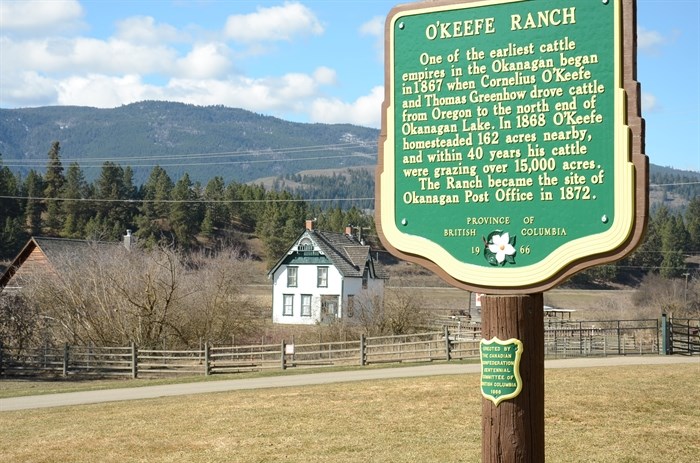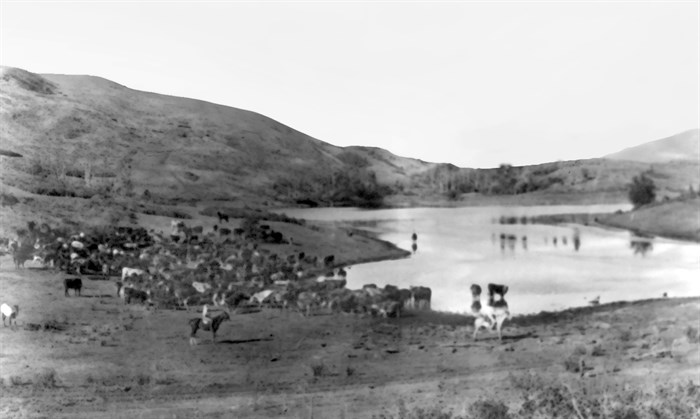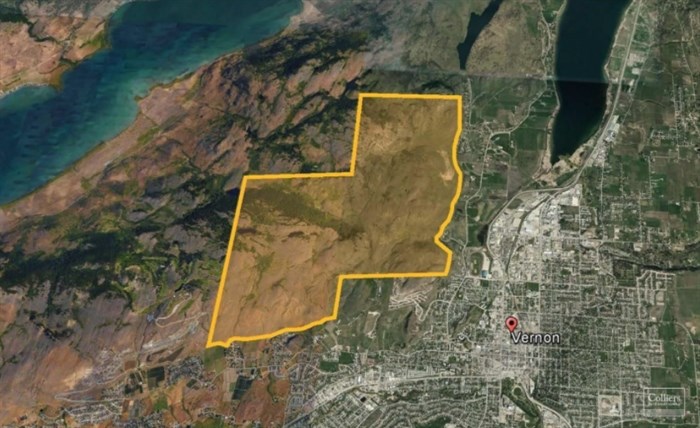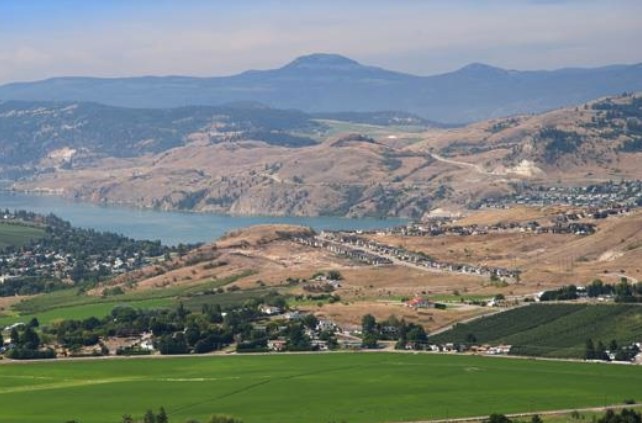
(BEN BULMER / iNFOnews.ca)
August 15, 2020 - 7:00 AM
Recently put on the market for $28.8 million, the land that Cornelius O’Keefe bought for a $1 an acre 150 years ago shows a rather healthy return on his original investment.
Currently owned by O'Keefe's descendants, the 2,310-acre site is prime development land for someone with deep pockets looking to invest in Vernon. Sitting on the plateau above Bella Vista Road and continuing north-east to Blue Jay Road, and west to the border with the Okanagan Indian Band reserve, the huge property brings forward the question: How did Cornelius O’Keefe get to own all that land in the first place?
Put simply, it can be summed up in one word: Colonialism.
"Anywhere the colonial powers went... through the rule of power they took what they wanted," historian Ken Mather told iNFOnews.ca.
Around the globe and throughout the British Empire, while some treaties were signed and agreements made with local people, the balance of power was not equal.
"It was a dominant society telling a less dominant society what they were going to accept," Mather added.
While the Syilx/Okanagan people had been in the area at least since the glaciers melted, when Cornelius O’Keefe arrived in 1867, the land was then the Colony of British Columbia and run from Victoria, which in turn took its orders from higher-ups in London.
The O'Keefe name is synonymous with Vernon, the same man behind the O'Keefe Ranch. Cornelius was one of the first white settlers in the North Okanagan. After arriving in the area, through the colonial government, he was given, with conditions, 160 acres of land, the maximum amount allowed.
"You could stay on that land and you had to make improvements to it and then you could buy it for a $1 an acre and get what was called a Crown Grant," Mather said. "You could get an initial 160 acres, but you could also buy land. There were various opportunities to get more land."
At the turn of the last century, a labourer's wage would have been $1 per day, making the land very affordable compared with today's standards.

Cattle grazing at Y Lake on the O'Keefe Range.
Image Credit: SUBMITTED: Historic O'Keefe Ranch
From the initial O'Keefe Ranch at the head of Okanagan Lake, the current-day site of the museum, O'Keefe kept buying land and growing his property.
While the Syilx/Okanagan people believed all the lands to be theirs, the British government also believed the same thing.
In 1860, a British civil servant began staking land for the local indigenous populations. A large piece of land that encompasses much of what is modern-day Vernon was earmarked. But the move angered some and in 1865 the boundaries were dramatically changed.
"So the reserve at that time comes down to two little postage stamps at the head of Okanagan Lake and nothing else," Mather said.
While the Syilx/Okanagan people debated declaring war in defence of their land rights, the federal Land Claims Commission stepped in and set the boundaries as they are today. Mather said "theoretically" the Commission gave the Syilx/Okanagan people a voice.
"But ultimately the First Nations people didn't have a lot of say in the matter," he said.
Still to this day, no treaty has ever been signed and the land remains the unceded territory of the Syilx/Okanagan people.
Around 200 years before O'Keefe's descendants became the benefactors of a multimillion-dollar piece of Vernon real estate, Cornelius O'Keefe's father left Ireland – which was also under British rule at the time having been invaded 300 years earlier. He settled near Ottawa and Cornelius was born in 1838, the youngest son of a large Irish Catholic family. It was the allure of gold that brought Cornelius to B.C. in 1862.
"(The) youngest son of a dirt poor Irish farmer, (Cornelius) basically would have to have cobbled together enough dollars to get himself to the Colony of British Columbia," Mather said.
And it wasn't an easy journey. Travelling east from Ottawa, Cornelius then boarded a ship that sailed down to Panama. Decades before the Panama Canal was built, a train took passengers across the country, who then boarded another ship travelling north.
In the 1860s, Cornelius began driving cattle from Oregon into the Okanagan before ultimately settling in the North Okanagan.
"O'Keefe was an entrepreneur, he was a guy that saw opportunity and took advantage of it," Mather said.
Over time, Cornelius grew his ranch and grazed thousands of cattle on the land. By the turn of the century, he'd amassed 12,000 acres.

The O'Keefe Range site.
Image Credit: Image Credit: Colliers International
At the time, India was the jewel in the crown of the British Empire and B.C. was never considered to be particularly important.
"Until they started growing apples here," Mather said. And Cornelius had been one of the first to do so and owned plenty of prime orchard land.
This isn't the first time the O'Keefe Range has been sold by the family.
Mather said in 1907 Cornelius sold large amounts of his land to the Land and Agricultural Company of Canada. The company wanted to subdivide and sell off orchards but then the First World War started and the land market crashed.
"The consortium running L and A was mostly Belgium capital," Mather said. "(And) Belgium takes a fairly big hit in the First World War."
Cornelius died in 1918, but his wife Elizabeth bought the land back. Their son, Tierney O’Keefe ran the ranch until the 1960s when the original homestead was turned into a museum. The Devonian Foundation bought what is now The Historic O’Keefe Ranch, before selling it to the City of Vernon in 1977 for $1.
But the 2,300 acres of the O'Keefe Range remained in the family. Mather said he believes parts are still leased for cattle grazing.
Cornelius' granddaughter Eileen Giuliani politely declined an interview request with iNFOnews.ca but said she'd ask other O'Keefes to see if a member of the family would to talk about the land sale. No one was forthcoming.

Image Credit: Image Credit: Colliers International
It's unclear how many of Cornelius descendants own the O'Keefe Range, and during his lifetime he fathered as many as 18 children.
Mather said Cornelius' first wife, Alapetsa, was an Okanagan Indian Band member.
"What most of the ranchers did in B.C. was they took indigenous wives and when they got a few dollars they sent their indigenous wives back to their reserves and searched out white wives," Mather said. "So (Cornelius) O'Keefe went back to his home near Ottawa and married Mary-Anne and had nine children."
When Mary-Anne died, Cornelius was in his sixties and married Elizabeth, 40 years his junior and had six more children, fathering his last child at age 76.
Mather said there would have been no official marriage between Cornelius and Alapetsa, but she does appear in the census in the 1870s. Some of the descendants of Cornelius and Alapetsa still live on the Okanagan Indian Band today, he said.
The Okanagan Range has also been on the market before. Sometime in the late nineties, a tentative deal was made between Cornelius' late son Tierney O'Keefe, and a developer. The deal soured and ultimately fell apart.
With the price set at $28.8 million, Colliers International realtor Mark Lester said it's next to impossible to estimate who and when the property would be sold. The future of the O'Keefe Ranch remains to be seen.
iNFOnews.ca made several attempts to contact the Okanagan Indian Band for input into this article but received no response.

Cornelius O'Keefe.
Image Credit: Image Credit: Historic O'Keefe Ranch collection 015
To contact a reporter for this story, email Ben Bulmer or call (250) 309-5230 or email the editor. You can also submit photos, videos or news tips to the newsroom and be entered to win a monthly prize draw.
We welcome your comments and opinions on our stories but play nice. We won't censor or delete comments unless they contain off-topic statements or links, unnecessary vulgarity, false facts, spam or obviously fake profiles. If you have any concerns about what you see in comments, email the editor in the link above.
News from © iNFOnews, 2020